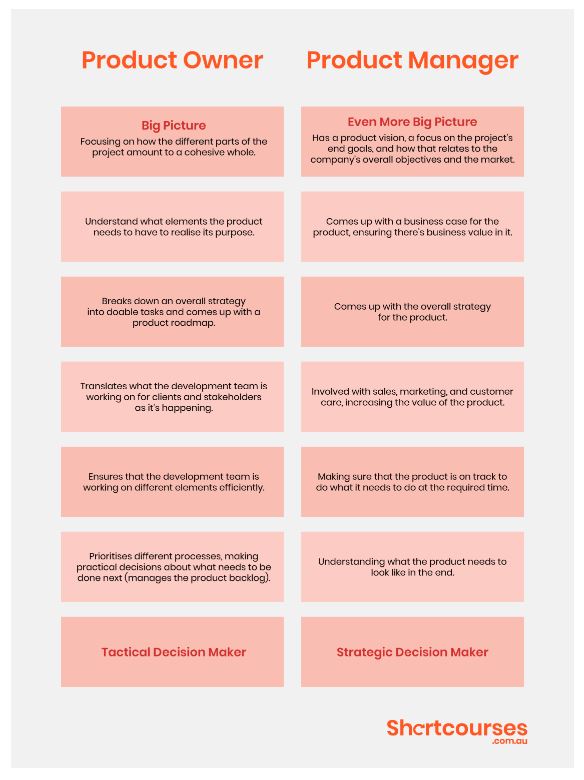How to Become a Product Owner in Tech
‘Product Owner’ is an emerging job of the future. Agile Scrum product owners ensure that the many parts of tech product development are integrated and efficient. They keep their eyes on the big picture as they guide members of their development team and keep stakeholders updated on product progress.
What is a Product Owner?
The Product Owner role was coined as part of the agile Scrum methodology for software design. Basically, if your agile team is using this methodology, you won’t be building a big piece of software in a slow, strict sequence. Instead, the project will be broken up into lots of smaller pieces. It will cycle through planning, execution, and feedback stages so that a product is developed quickly and with good functionality. The product is then continuously improved through new iterations as you add more features and iron out bugs. The aim is to deliver new software capability every 2-4 weeks in “sprints”.
The project benefits from continuous collaboration, ensuring that stakeholders have a say while it’s still adaptive to their opinions.
Managing the stakeholders, development team, processes, dependencies, and capabilities of a piece of software is a big job! What agile Scrum product owners do is variable through different organisations, but they’re generally responsible for:
- Knowing every part of the productIts purpose, how it works, and what each small part does.
- Understanding the end-userWho they are and what they need, and how the product design appeals to them and increases functionality.
- Planning workMotivating and setting out the goals for the development team, designing acceptance criteria that set out the required amount and quality of work.
- Prioritising tasksSorting the product backlog items based on what needs to be worked on first, and what could be an optional add-on if you have the time – and reshuffling those priorities as the project changes (backlog refinement).
- Updating clients and stakeholdersKeeping stakeholders updated on the project and integrating their feedback.
- DirectionAlways having a good idea of where the product is at in all stages of development, and where it’s heading.
It’s a satisfying and financially rewarding job that’s among the top 7 jobs of the future in Australia.

Product Owner vs Product Manager
Agile product ownership is similar but different in scope to agile product management when it comes to product development. Both need to be effective decision-makers with excellent communication skills and clarity about what the product does.
While product owner responsibilities include making sure the development team is well organised, and prioritising and tackling tasks efficiently, the product manager is looking at an even bigger picture.
Product managers look to the market to see what products are needed, and what would fill an existing gap. They’re customer-focused, involved with communicating between the development team and stakeholders, as well as collaborating with sales and marketing team members. They know what the product does and why, but they’re less involved with the day-to-day processes of delivering it.

How to Become a Product Owner
Product owners need great tech skills, communication skills, decision-making skills, prioritisation experience, project management skills, and leadership skills.
Formal qualifications are not essential for the role, but they are useful and viewed favourably. 82% of Product Owners have at least a Bachelor’s Degree qualification and a third hold a Master’s degree. The most relevant fields of study are computer science, IT, and business.
There are very few entry-level Product Owner jobs because the on-the-job experience is necessary.
Path One
One route to getting a Product Owner job is to get an entry-level position at a company that uses the Scrum agile methodology and gain enough experience to get promoted into the role.
Path Two
Another route would be to apply for a Product Owner position after getting further training or qualifications and on-the-job experience to show you have the above skills and apply for jobs directly.
Project Management Short Courses and leadership training would supplement a solid technology education. You could even get a qualification certified by Scrum, such as a Product Owner Certification, which would provide specific, relevant training on being part of a Scrum team and becoming a Scrum master.
To get on-the-job experience, you could look for more junior roles such as:
- Software Tester
- Business Analyst
- Software Engineer
- Tech Project Manager
- Technology Consultant
- Database Administrator
- User Experience Design
- Otherwise working with user stories
Technical roles with a business side which requires strong communication skills and cooperation with stakeholders would be advantageous, as would positions that expose you to the Scrum agile methodology.
Tech is a vibrant and growing field, but it can also be very competitive. Working hard to gain experience and knowledge in product development will likely lead to payoffs in the form of getting well-paying, future-proof, and complex-but-rewarding product owner roles.